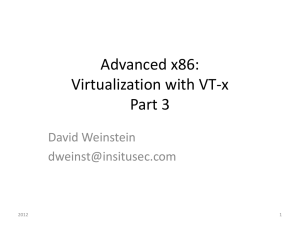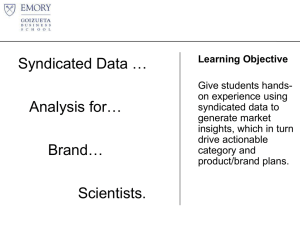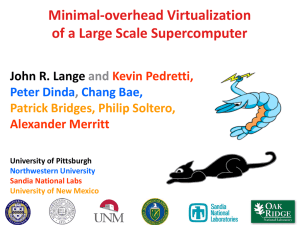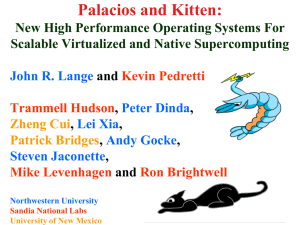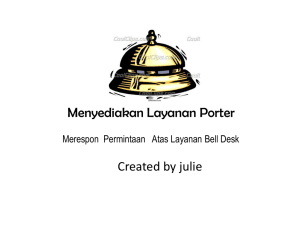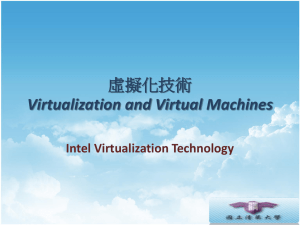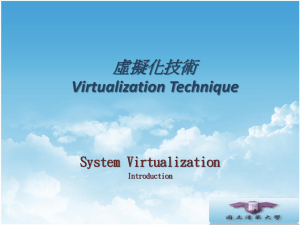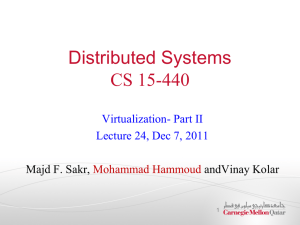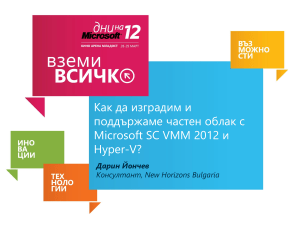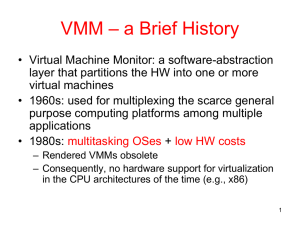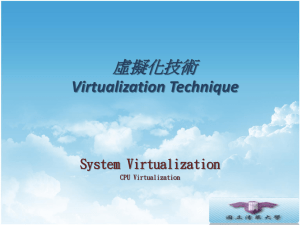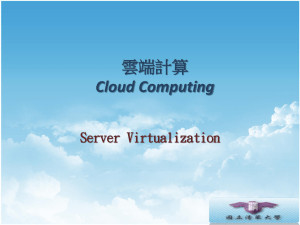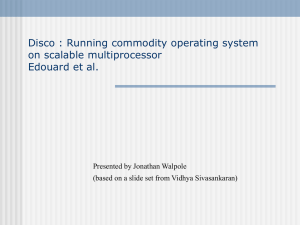vee11-symcall
advertisement
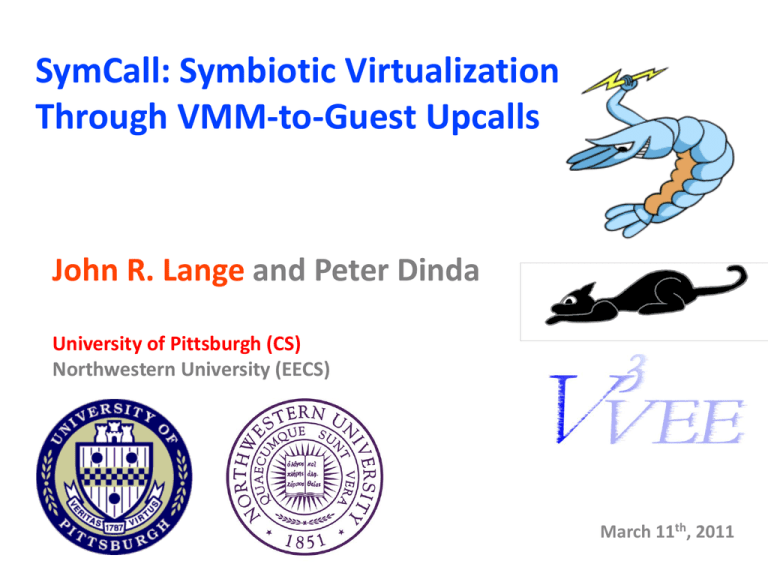
SymCall: Symbiotic Virtualization Through VMM-to-Guest Upcalls John R. Lange and Peter Dinda University of Pittsburgh (CS) Northwestern University (EECS) March 11th, 2011 Summary • Virtualization can scale – Near native performance for optimized VMM/guest (within 3%) • VMM needs to know about guest internals – Should modify behavior for each guest environment – Example: Paging method to use depends on guest • Black Box inference is not desirable in HPC environment – Unacceptable performance overhead – Convergence time – Mistakes have large consequences • Need guest cooperation – Guest and VMM relationship should be symbiotic 2 Outline • Semantic Gap – VM introspection is hard • Symbiotic Virtualization – Specifically design VMM/OS to maximize information sharing • SymCall – Synchronous upcalls into a running VM • SwapBypass – Transparently increase guest memory space Semantic Gap • VMM architectures are designed as black boxes – Explicit OS interface (hardware or paravirtual) – Internal OS state is not exposed to the VMM • Many uses for internal state – Performance, security, etc... – VMM must recreate that state • “Bridging the Semantic Gap” – [Chen: HotOS 2001] • Two existing approaches: Black Box and Gray Box – Black Box: Monitor external guest interactions – Gray Box: Reverse engineer internal guest state – Examples • Virtuoso Project • Lycosid, Antfarm, Geiger, IBMon, many others 4 Example: Swapping • Disk storage for expanding physical memory Application Memory Working Set Swapped Memory Physical Memory Guest VMM Swap Disk Only basic knowledge without internal state 5 Symbiotic Virtualization • Bridging the semantic gap is hard – Can we design a virtual machine interface with no gap? • Symbiotic Virtualization – Design both guest OS and VMM to minimize semantic gap – 2 components • Guest OS provides internal state to VMM • Guest OS services requests from VMM – Interfaces are optional 6 Symbiotic Interfaces • SymSpy Passive Interface – Internal state already exists but it is hidden – Asynchronous bi-directional communication • via shared memory – Structured state information that is easily parsed • Semantically rich • SymCall Functional Interface – Synchronous upcalls into guest during exit handling – API • Function call in VMM • System call in Guest – Brand new interface construct 7 Symbiotic Discovery • A symbiotic OS must run on real hardware – Interface must be based on hardware features • CPUID – Detection of Symbiotic VMM • MSRs – Configuration of Symbiotic interfaces 8 SymSpy • Shared memory page between OS and VMM – OS uses MSR to map into address space • Standardized data structures – Shared state information • Read and write without exits 9 SymCall (Symbiotic Upcalls) • Conceptually similar to System Calls – System Calls: Application requests OS services – Symbiotic Upcalls: VMM requests OS services • Designed to be architecturally similar – Virtual hardware interface • Superset of System Call MSRs – Internal OS implementation • Share same system call data structures and basic operations • Guest OS configures a special execution context – VMM instantiates that context to execute synchronous upcall – Symcalls exit via a dedicated hypercall 10 SymCall environment • Specified in virtual SYMCALL MSRs – Based on System Call MSRs – VMM copies values into hardware control registers • SYMCALL MSRs – SYMCALL_RIP • Global code entry point for all symcalls – SYMCALL_RSP • Stack frame used by SymCall – SYMCALL_CS (+SS) • Code segment and Stack segment used for SymCall • Enables kernel mode execution – SYMCALL_GS and SYMCALL_FS • Special segments that point to per CPU data structures 11 SymCall Control Flow Handle exit 12 Existing Implementation • Symbiotic Linux guest OS – Exports SymSpy and SymCall interfaces • Palacios – Fairly significant modifications to enable nested VM entries • Re-entrant exit handlers • Serialize subset of guest state out of global hardware structures 13 Restrictions • Currently designed for short queries – Narrow focus allows behavioral guarantees • Restrictions: – Only 1 symcall active at a time – Symcalls run to completion • No blocking – Blocking would allow asynchronous behavior • No context switches • No injected exceptions or interrupts – Symcalls cannot wait on locks • Waiting would make deadlocks possible 14 Example: SwapBypass • Purpose: prevent thrashing situations – Temporarily expand guest memory – Completely bypass the Linux swap subsystem • Enabled by SymCall – Not feasible without symbiotic interfaces • VMM detects guest thrashing – Shadow page tables used to prevent it 15 Symbiotic Shadow Page tables Guest Page Tables PDE Shadow Page Tables PDE PTE PTE Physical Memory Physical Memory Swap Disk Cache Swapped out page Swap Bypass Page 16 SwapBypass Concept Application Working Set Guest 2 Guest 3 Swapped Memory Guest Physical Memory Swap Disk VMM physical Memory Global Swap Guest 3 Disk Cache Swap Disk Guest 2 Guest 1 17 Necessary SymCall: query_vaddr() 1. Get current process ID – get_current(); (Internal Linux API) 2. Determine presence in Linux swap cache – find_get_page(); (Internal Linux API) 3. Determine page permissions for virtual address – • find_vma(); (Internal Linux API) Information extremely hard to get otherwise 18 Evaluation • Memory system microbenchmarks – Stream, GUPS, ECT Memperf – Configured to overcommit anonymous memory • Cause thrashing in the guest OS • Overhead isolated to swap subsystem – Ideal swap device implemented as RAM disk • IO occurs at main memory speeds • Provides lower bound for performance gains 19 Stream Runtime Ideal swap cache improvement Working set size 20 Conclusion Palacios: http://www.v3vee.org/palacios V3VEE Project: http://www.v3vee.org System Calls • Entry points into Kernel – Provides privileged services for applications • Device IO, address space modifications, etc… • Extensive hardware support – Fast entry to preconfigured execution state • Switch from user mode to kernel mode • Kernel specifies execution environment to hardware – Model Specific Registers (MSRs) – Special instructions for kernel entry/exit • SYSENTER and SYSEXIT • SYSCALL and SYSRET 22
